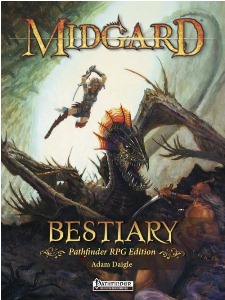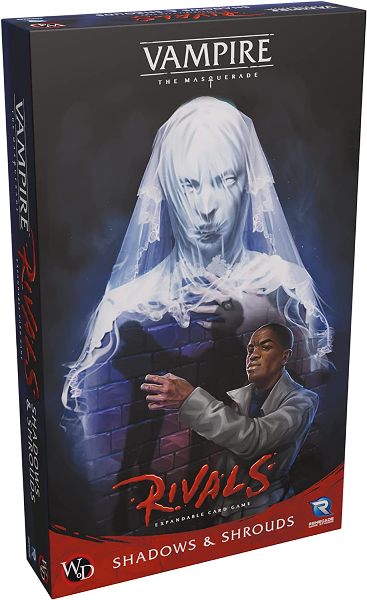Midgard: Bestiary
This bestiary is a core supplement of the Midgard setting for the Pathfinder Roleplaying Game written by Adam Daigle and published by Open Design.
By The Warden

I love monster books. For any system, anything involving wicked creatures of the deep, denizens of the sky, frothing beasts in the wild, and especially risen forms of the undead and Machiavellian servants of devilry has me wrapped around its clawed finger. In my heyday of playing D&D or other fantasy RPGs, each session’s goals and storylines would be drawn from a casual flip-through of every monster book I could get my hands on until I found something which popped out of the page and beckoned to be thrown against the heroes that week. In other words, I’ve built entire worlds around monsters.
The team at Open Design have put out their version of monstrosity for the Midgard setting for both the AGE System and Pathfinder; today, we’ll take a look at the Pathfinder version.
CONTENT
There are certain publishers/authors projecting a particular expectation when it comes to monster books and I think it’s safe to say Open Design is definitely on the top 10 of everyone’s lists. They’ll not be disappointed. There is a wide range of creatures – from vile to friendly – listed throughout this book. More importantly, they maintain a certain amount of consistency in theme. There have been some monster supplements out there offering so much variety in power, range, and depth for a particular campaign setting, it seems the authors just poured out every single cockamamie idea they could come up with. The Bestiary holds to a value of expectation and while I’m not familiar with the Midgard setting, the creatures provided here all seem appropriate within the same world. They all seem to hold a very Norse mythological quality to them, which I’m told is exactly what’s to be expected.
The artwork is absolutely amazing and evocative. Let’s admit it, the artwork on a particular monster is what makes the initial sale, the flashy red sports car outside the dealership, and every creature in here does not disappoint. The layout is smooth and stylish, complimenting everything else found in these pages. It’s an absolutely gorgeous book to read through until you start to notice tiny glitches here and there.
Normally, I’m not entirely fussy during my initial review and it’s always possible for little errors here and there to miss the casual reader’s attention, but these kind of products demand accuracy, especially when using a system with a 500+ page rulebook. When I took the time to read through the entries carefully, I found some discrepancies in text, stat layout, even missing special abilities.
For example, the death butterfly swarm has a Distraction special ability listed on their stat block with the appropriate save DC in brackets, but no corresponding detail explaining how this ability works. (I also double-checked my copy of the Pathfinder rulebook to find a listing for a Distraction condition or anything else in the appendices and found nothing there. While it’s possible such a pre-existing condition exists in another supplement, it’s a mystery to me as is.) There are other special abilities describing any creature affected by the swarm’s Distraction are additionally subjected to these other abilities, but using the swarm exactly as written, it seems as if Distraction merely unlocks additional abilities. Considering the thoroughness of Pathfinder’s monster stat blocks to include whether a creature uses it’s Charisma for Will saves and modifiers already built into its skills, this kind of missing entry is significant. GMs be aware, you’ll need to fill in some gaps or check for some errata.
OVERALL
Despite the errors mentioned above, it’s still an excellent guide to beasts, humanoids, giants, undead, and demons in the world of Midgard. Even if you have your own campaign world with a Norse-based mythology, this will definitely fill your lands with enough ferocity to make players wonder why anyone ever tried to settle there in the first place.
RATINGS
Publication Quality: 8 out of 10
During my initial read-through, I was thoroughly impressed with the quality of this book (or PDF, as my case may be), but I did notice some layout goofs (differences in tab spacing, widows, things like that). For most people, I just sound really fussy, but that’s what happens when you’re in the graphics business.
Mechanics: 8 out of 10
Pathfinder can be an exceedingly complex system to build monsters with and it’s no small measure to create even a CR 1 animal with so many factors to keep in check, let alone the use of templates and player character races. This book does a good job keeping it all together and providing some new and interesting abilities to keep experienced players on their toes.
As I mentioned before, there are the occasional omissions here and there preventing a perfect score. Most of this I account to having so many hands in the same pot. Some attack listings include critical modifiers (presented either as 1d8+6/20/x2 or 1d8+6/x2 or without any at all), references to different names for different creatures (what are clockwork watchers?). As a GM, most of these are minor, but some can lead to questions and filling in the gaps yourself.
Desire to Use: 10 out of 10
While I only play Pathfinder and have yet to run a session of my own, I’ve eagerly alerted my GM about this book and hope he doesn’t catch on to the fact that I’ve read up on many of these monsters already. Plus, I’m trying to find out how I can become one of Baba Yaga’s Horsemen.
Overall: 9 out of 10
You can’t go wrong with the monsters provided in the Midgard Bestiary and when it comes to the object of any monster book, it excels at inspiring mayhem and destruction against PC and NPC alike. Any negatives I mention here are minor and do not detract enough from my overall opinion of this book, which is to highly recommend it to anyone running Pathfinder.





You’ll actually find that many of those are “universal monster abilities,” which are described in detail in the back of the Pathfinder Bestiary. The practice is to *not* include the full description of the ability when it matches the UMA.
Distraction, for instance, is there. You can see it in the d20pfsrd here:
http://www.d20pfsrd.com/bestiary/rules-for-monsters/universal-monster-rules#TOC-Distraction-Ex-
Ah. I don’t have the PF bestiary, but still found it odd no references are included. For me, little details like that can slow down games. Not a big deal and had no bearing on scoring for this review.